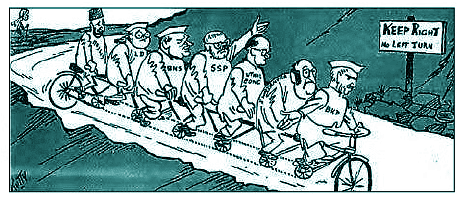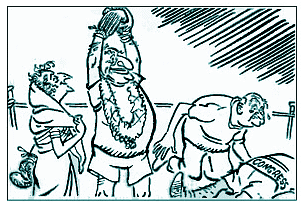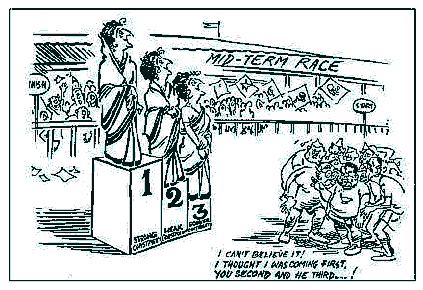Passage Based Questions: Challenges to and Restoration of Congress System - 2 | Political Science Class 12 - Humanities/Arts PDF Download
| Table of contents |

|
| Passage - 1 |

|
| Passage - 2 |

|
| Passage - 3 |

|
| Passage - 4 |

|
| Passage - 5 |

|
| Passage - 6 |

|
| Passage - 7 |

|
Passage - 1
Direction: Read the passage given below and answer the questions that follow:
The defeat of the official Congress candidate formalized the split in the party. The Congress President expelled the Prime Minister from the party; she claimed that her group was the real Congress. By November 1969, the Congress group led by the ‘syndicate’ came to be referred to as the Congress (Organization) and the group led by Indira Gandhi came to be called the Congress (Requisitionists). These two parties were also described as Old Congress and New Congress. Indira Gandhi projected the split as an ideological divide.
(i) To which election does the passage refer?
Ans: The passage refers to the Presidential Elections of 1969.
(ii) Who was the official Congress candidate in that election?
Ans: The official Congress candidate was N. Sanjeeva Reddy.
(iii) Why did the Congress President expel the Prime Minister from the party?
Ans: The Prime Minister, Indira Gandhi, had proposed the name of V. V. Giri against the official candidate of her own party, who eventually defeated the official candidate of Congress.
(iv) How did Indira Gandhi view the split in the Congress as an ideological divide?
Ans: Indira Gandhi viewed the split as an ideological divide because the Syndicate was of capitalist ideology, while the group led by Indira Gandhi adopted a socialistic approach.
Passage - 2
Direction: Read the passage given below and answer the questions that follow:
The year 1967 is considered a landmark year in India’s political and electoral history. The Congress party remained a dominant force throughout the country from 1952 onwards. This trend was to undergo significant changes with the 1967 elections. It was in the context of heightened popular discontent and the polarization of popular forces that the fourth general elections of the Lok Sabha and State Assemblies were held in February 1967. The results jolted the Congress at both the national and state levels. Many contemporary political observers described the elections as a political earthquake.
(i) Discuss the socio-economic and political context of the 1967 general elections in India.
Ans: (a) This period was marked by a grave economic crisis due to successive failures of monsoons, widespread drought, decline in agricultural production, serious food shortages, depletion of foreign exchange reserves, sharp rise in military expenditure, and diversion of resources from planning and economic development.
(b) The economic situation triggered a price rise, leading to protests against increased prices of essential commodities, food scarcity, growing unemployment, and overall economic conditions. Bandhs and hartals were frequently called across the country.
(c) Opposition parties were active in organizing public protests and pressuring the government. Parties opposed to the Congress realized that the division of their votes kept Congress in power. Thus, parties with different ideologies and programs came together to form anti-Congress fronts, known as non-Congressism.
(ii) Why were the 1967 general elections described as a ‘political earthquake’ by many political observers?
Ans: (a) The elections were described as a ‘political earthquake’ because, although Congress did secure a majority in the Lok Sabha, it achieved its lowest tally of seats and share of votes since 1952.
(b) At the state level, the Congress lost elections in seven states and could not form the government in two other states due to defection.
Passage - 3
Direction: Study the picture given below and answer the questions that follow:
 (i) What is meant by ‘Keep Right, No Left Turn’?
(i) What is meant by ‘Keep Right, No Left Turn’?
Ans: The United Front Party was formed based on a non-Communist ideology and was supposed to follow the ‘rightist’ only.
(ii) In the picture, what do the following stand for:
(a) LD
(b) BKS
(c) SSP
(d) BKD
Ans.
(a) Lok Dal
(b) Bihar Kranti Sabha
(c) Samyukt Socialist Party
(d) Bharatiya Kranti Dal
(iii) What is a hung assembly?
Ans: A hung assembly is a situation where no single party is able to secure a majority in the election.
Passage - 4
Direction: Study the picture given below and answer the questions that follow:

(i) What does the cartoon represent?
Ans: It represents the Presidential elections of 1969.
(ii) Identify the lady in the cartoon and explain the reason for her pleasure.
Ans: The lady is Indira Gandhi, and she is pleased because her nominee won the presidential elections.
(iii) Identify the person wearing a garland in the winning position.
Ans: The person is V. V. Giri.
(iv) Who is lying on the ground?
Ans: The person lying on the ground is N. Sanjeeva Reddy.
Passage - 5
Q. 1. Read the passage given below carefully and answer the questions that follow:
The New Congress had something that its big opponents lacked – it had an issue, a positive agenda, and a slogan. The Grand Alliance did not have a coherent political programme. Indira Gandhi said that the opposition alliance had only one common programme, ‘Indira Hatao’. In contrast to this, she put forward a positive programme captured in the famous slogan ‘Garibi Hatao’.
(i) Which Congress party is referred to as ‘the New Congress’?
Ans: The Congress is referred to as the New Congress.
(ii) Mention any two measures taken by Indira Gandhi to combat poverty.
Ans: The two measures taken by Indira Gandhi were the growth of the public sector and the reduction of the gap between income and opportunity.
(iii) How justified is it to call the opposition alliance the ‘Grand Alliance’?
Ans: The opposition alliance was truly a Grand Alliance as it included an unprecedented number of political parties.
Passage - 6
Q. 2. Read the passage given below carefully and answer the questions that follow:
“…… Indira Gandhi changed the Congress into a highly centralised and undemocratic party organisation, from the earlier federal, democratic, and ideological formation that Nehru had led…… But this …… could not have happened had not Indira Gandhi changed the entire nature of politics. This new, populist politics turned political ideology…… into a mere electoral discourse, use of various slogans not meant to be translated into government policies…… During its great electoral victories in the early 1970s, amidst the celebration, the Congress party as a political organisation died……”. — Sudipta Kaviraj
(i) According to the author, how did Nehru’s and Indira Gandhi’s strategies differ?
Ans: While Nehru led Congress as a democratic and ideological party, Indira Gandhi transformed Congress into an undemocratic and centralised party.
(ii) Why does the author claim that the Congress party ‘died’ in the seventies?
Ans: The author uses the term ‘died’ to indicate that the Congress party had fundamentally changed from its original setup and ideology. The revived Congress was significantly different from the original party, which had essentially ended.
(iii) How did the changes within the Congress party impact other political parties?
Ans: The changes in Congress led to shifts in ideology and prompted other political parties to form coalitions.
Passage - 7
Direction: Study the picture given below and answer the questions that follow:
(i) What election results are depicted in the cartoon?
Ans: The cartoon depicts the results of the 1971 elections.
(ii) How did the cartoonist interpret the outcome of these elections?
Ans: The outcome of the 1971 elections was interpreted as “The Grand Finish” by the cartoonist.
(iii) Who are represented as the players in the cartoon?
Ans: The players on the ground are the leading opposition figures of that time.
|
34 videos|305 docs|51 tests
|
FAQs on Passage Based Questions: Challenges to and Restoration of Congress System - 2 - Political Science Class 12 - Humanities/Arts
| 1. What were the main challenges faced by the Congress system in India during the late 20th century? |  |
| 2. How did the Congress party restore its influence after facing significant challenges? |  |
| 3. What role did coalition politics play in the restoration of the Congress system? |  |
| 4. What impact did the Emergency period have on the Congress party's reputation? |  |
| 5. How did social movements influence the Congress party's policies and strategy? |  |




















